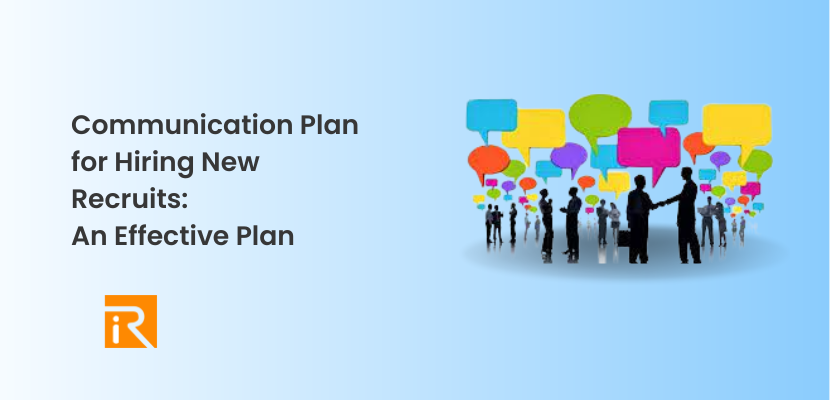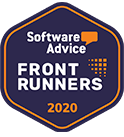A communication plan for hiring new recruits is an integral part of the recruitment process, yet it is often overlooked. A well-structured communication plan not only helps in attracting the right talent but also plays a crucial role in engaging and retaining new hires.
Essentially, it sets the stage for the entire recruitment process by outlining the steps, tools, and strategies to effectively communicate with potential candidates from the first point of contact to onboarding.
In this comprehensive guide, we dive deep into how to create a compelling communication plan for hiring new recruits.
The goal? To help you create an effective communication strategy that streamlines your hiring process reduces time-to-hire, and enhances the candidate experience.
Communication Plan in Recruitment
Certainly, a communication plan for hiring new recruits is far more than just disseminating job postings and passively awaiting applications. It functions as a strategic tool that enables organizations to attract, engage, and retain the right talent.
With effective communication, clear expectations are set, which subsequently reduces uncertainty and fosters trust with potential candidates. Moreover, it ensures a smooth and efficient recruitment process.
This results in effectively eliminating misunderstandings that could otherwise lead to delays and missed opportunities.
Progressing further, having a comprehensive communication plan for hiring recruits proves to be indispensable for your employer brand as well.
Essential Elements of a Communication Plan for Hiring New Recruits
Creating a communication plan for hiring recruits involves several crucial steps:
Defining your organization’s needs and goals
This involves identifying the skills, qualifications, and characteristics needed for the job, as well as the objectives of the recruitment process.
Crafting a comprehensive job description
A detailed job description is the cornerstone of your communication with potential candidates. It sets clear expectations and helps attract the right talent.
Choosing the right channels for job postings
Different channels attract different types of candidates. Selecting the appropriate ones for your job postings is key to reaching your target audience.
Creating an engaging application process
The application process should be straightforward, engaging, and user-friendly to encourage potential candidates to apply.
Developing a consistent communication strategy with applicants
Regular communication with applicants keeps them engaged and informed throughout the recruitment process.
Proactive candidate management
This involves keeping in touch with potential candidates, providing updates, and maintaining their interest in the job.
Interview scheduling and confirmation
Effective communication helps ensure that interviews are scheduled and confirmed efficiently, reducing the likelihood of no-shows.
Post-interview communication
Providing feedback and the next steps after the interview can significantly enhance the candidate experience.
Job offer and onboarding communication
A well-crafted job offer and a comprehensive onboarding process can help make new hires feel welcome and set them up for success.
Regular check-ins and feedback
Maintaining open lines of communication with new hires helps build a strong employer-employee relationship.
Setting the Stage: Defining Your Organization’s Needs and Goals
The foundation of an effective communication plan for hiring recruits is understanding your organization’s needs and goals. This is not just about filling a vacant position but finding the right fit that aligns with your company’s culture, values, and long-term objectives.
Having a clear understanding of what you’re looking for will guide your entire recruitment communication strategy. It involves crafting a comprehensive job description selecting the right channels for job postings and engaging with potential candidates.
Crafting a Comprehensive Job Description
A job description is more than a list of duties and responsibilities. It’s your first communication tool with potential candidates. It plays a vital role in attracting the right talent.
Additionally, a well-written job description sets clear expectations and highlights the benefits of the role. It provides a glimpse into your company’s culture.
Here are some key elements to include in your job description:
Job title
Make sure it is clear, descriptive, and reflects the nature of the job.
Summary of the role
Provide an overview of the position. Additionally, including its purpose and importance within the company.
Key Responsibilities
List the primary duties and tasks the job involves.
Skills and qualifications
Outline the required and preferred technical skills. Additionally, educational qualifications, and any specific experiences.
Soft skills
Highlight the personal attributes that would contribute to success in the role.
Company culture and values
Give potential candidates a sense of your company’s ethos and working environment.
Benefits and opportunities
Highlight the job’s perks, including career development opportunities, benefits, and any unique selling points of your company.
Remember, transparency is key. An accurate and detailed job description will attract candidates who fit the role and your organization well.
Employer Branding: The Power of Communication
Your employer brand is the image and reputation of your company as a place to work. A strong employer brand can give you a competitive edge in attracting and retaining top talent.
Communication plays a crucial role in shaping your employer brand. When creating a communication plan for hiring recruits, consider the following:
Consistent messaging
Ensure that all your communication reflects your employer brand, from the job description and application process to interviews and onboarding.
Transparency
Be open and honest about what it’s like to work at your company. Authenticity builds trust and makes you more attractive to potential candidates.
Employee advocacy
Encourage your employees to share their experiences and perspectives. This can be through testimonials, social media posts, or participation in recruitment events.
Responsive and respectful communication
Treat every candidate with respect, even those you don’t hire. Respond promptly to inquiries, provide feedback, and keep applicants informed about the status of their applications.
Choosing the Right Channels for Job Postings
The channels you use to post your job vacancies play a critical role in reaching your target audience. Consider the following when selecting your channels:
Job boards
These are a popular choice for job postings due to their wide reach. However, it’s crucial to choose the right job boards that cater to your industry or the specific role you’re hiring for.
With its professional focus, LinkedIn is an effective channel for targeting both active and passive candidates.
Company website
Posting jobs on your company website can attract candidates who are interested in your company and have taken the initiative to check out your careers page.
Social media
Platforms like Facebook and Twitter can help you reach a broader audience, especially for roles that require digital savvy.
Industry-specific sites or forums
These can help you target a specific group of professionals in your industry.
Employee referrals
This can be a highly effective way to find quality candidates. Consider implementing an employee referral program if you don’t already have one.
Each channel has its advantages and disadvantages, so it’s worth using a combination of different channels to maximize your reach and find the right candidates.
Creating an Engaging Application Process
The application process is often a candidate’s first real interaction with your organization, so it’s essential to make it as straightforward, intuitive, and engaging as possible.
This can greatly impact the candidate’s perception of your company and determine whether they continue with their application.
Here are some strategies to consider:
User-friendly application forms
Ensure that your application forms are easy to understand and navigate. Additionally, avoid asking for unnecessary information and limit the length to keep candidates engaged.
Clear instructions
Clearly outline the steps involved in the application process, including what materials are needed (e.g., resume, cover letter, portfolio), how to submit them, and the expected timeline.
Personalized auto-responders
Acknowledge receipt of the application and provide an estimated timeline for the next steps. This not only assures candidates that their application has been received but also sets expectations for the process.
Mobile compatibility
With many job seekers now using their mobile devices for job hunting, it’s essential to ensure your application process is mobile-friendly.
Developing a Consistent Communication Strategy with Applicants
Keeping applicants informed throughout the hiring process is crucial for maintaining their interest and engagement. Here are some ways to ensure consistent communication:
Regular updates
Provide regular updates on the status of the application, even if it’s just to say the process is still ongoing. This reduces uncertainty and frustration for candidates.
Clear points of contact
Ensure applicants know who to contact if they have any questions or issues during the application process.
Feedback
If an applicant is unsuccessful, consider providing feedback on their application. This can help them improve for future opportunities and leaves a positive impression on your company.
Leveraging Social Media and Technology
Social media and technology can be powerful tools for engaging with potential candidates and promoting your company culture.
Social media recruitment
Platforms like LinkedIn, Facebook, and Twitter can be used to post job openings, share company news and updates, and engage with potential candidates.
Video interviews
For remote positions or initial screening interviews, video technology can be a cost-effective and efficient solution.
Online assessments
Online skills tests or personality assessments can be useful tools for screening applicants and finding the best fit for the role.
Proactive Candidate Management
Rather than just reacting to applications as they come in, proactive candidate management involves actively seeking out potential candidates and building relationships for future opportunities.
Talent pool
Develop a database of potential candidates who have either applied previously, been referred, or otherwise identified as potential fits for your company.
Networking
Attend industry events, job fairs, or online networking platforms to connect with potential candidates.
Employee referrals
Encourage your employees to refer potential candidates, as they are likely to know people with the right skills and cultural fit.
Interview Scheduling and Confirmation
Effective communication is key in scheduling and confirming interviews. Consider the following strategies:
Flexibility
Allow candidates to choose from multiple potential interview times.
Confirmation and reminders
Send a confirmation email with the date, time, and location (or video link for remote interviews) of the interview. Send a reminder the day before.
What to expect
Let candidates know what to expect during the interview, including who they will be meeting with and any documents or materials they should bring.
Crafting a Comprehensive Onboarding Process
The communication plan for hiring recruits doesn’t end with a job offer. A well-structured onboarding process is a crucial component of your communication strategy.
Additionally, onboarding is an opportunity to reaffirm the recruit’s decision to join your organization and to foster their integration into your company culture. Therefore, it’s the first step in building a strong and productive relationship with your new hire.
Here’s how to create a comprehensive onboarding process:
Welcome package
A welcome package can be an effective tool to introduce your company’s culture and expectations. Additionally, this could include a welcome letter, employee handbook, company merchandise, or even personalized items to make the new hire feel part of the team.
Orientation
This is a chance to provide an overview of the company’s mission, values, goals, and structures. It’s also a good opportunity to introduce the new hire to key team members and their roles.
Job-specific training
This helps the new recruit understand their role, responsibilities, and performance expectations. The training could be in the form of mentoring, workshops, or online courses.
Regular check-ins
Regular follow-up meetings can help identify any issues or concerns and make the new hire feel supported. These can also be an opportunity to provide constructive feedback and guide their professional development.
Legal Considerations in Recruitment Communication
When developing a communication plan for hiring new recruits, it’s important to be aware of legal considerations. This includes anti-discrimination laws, data protection regulations, and right-to-work checks.
Employers must ensure that their job advertisements, application process, and selection criteria do not discriminate. Also, companies need to ensure they handle candidate data in compliance with data protection laws. This includes gaining consent before collecting personal data and securely storing and handling this data.
Communication Challenges
The recruitment process can pose several communication challenges. This includes managing a high volume of applicants, maintaining engagement with potential hires, and providing negative feedback.
Here are some strategies to address these challenges:
Use technology
Applicant tracking systems can help manage large volumes of applications and ensure timely and consistent communication with all applicants.
Personalize communication
While it’s important to have a standardized communication plan for hiring new recruits, adding a personal touch can make candidates feel valued and engaged.
Provide constructive feedback
While giving negative feedback can be difficult, it can also be valuable for the candidate’s professional development. Keep it constructive, focus on the skills and experience, and be respectful and empathetic.
Conclusion
First, we need a clear plan for hiring new people, where everyone knows their jobs. We then choose the best ways to talk and share details. A timeline is important to keep us all on track.
We must write clear messages to find the right people and always remember to follow up with them. Finally, we should always check if things are working well and make improvements if needed.
At last, good communication is the base for the communication plan for hiring new recruits.
FAQs
- What is the importance of a communication plan in the hiring new recruits process?
Undoubtedly, a communication plan holds substantial importance as it not only streamlines the hiring process but also greatly enhances the candidate’s experience, all while establishing a strong reputation for your company.
- What are the key components of a successful communication plan for hiring new recruits?
Moving on to the components, the key elements that underpin a successful communication plan for hiring notably include setting clear goals, defining roles and responsibilities, and choosing the right communication channels. Additionally, I constructed a timeline, drafted clear messages, implemented a follow-up strategy, and continuously evaluated and refined the plan.
- How can technology support my communication plan for hiring new recruits?
In terms of technological support, various innovative tools and technologies can effectively automate certain tasks, facilitate seamless communication, and provide valuable insights. This support ultimately enhances the overall efficiency and effectiveness of your communication plan.
- How often should I evaluate and refine my communication plan for hiring new recruits?
Regarding the frequency of evaluations, it is highly recommended to constantly monitor your communication plan’s effectiveness and refine it whenever necessary. This practice ensures that your plan remains both effective and relevant.
- What are some common pitfalls in a communication plan for hiring new recruits and how can I avoid them?
Lastly, some common pitfalls to watch out for include unclear goals, poor delegation, inefficient communication channels, an unrealistic timeline, and a lackluster follow-up strategy. To steer clear of these, it is advisable to steadfastly adhere to the guidelines and best practices discussed in this guide.






















